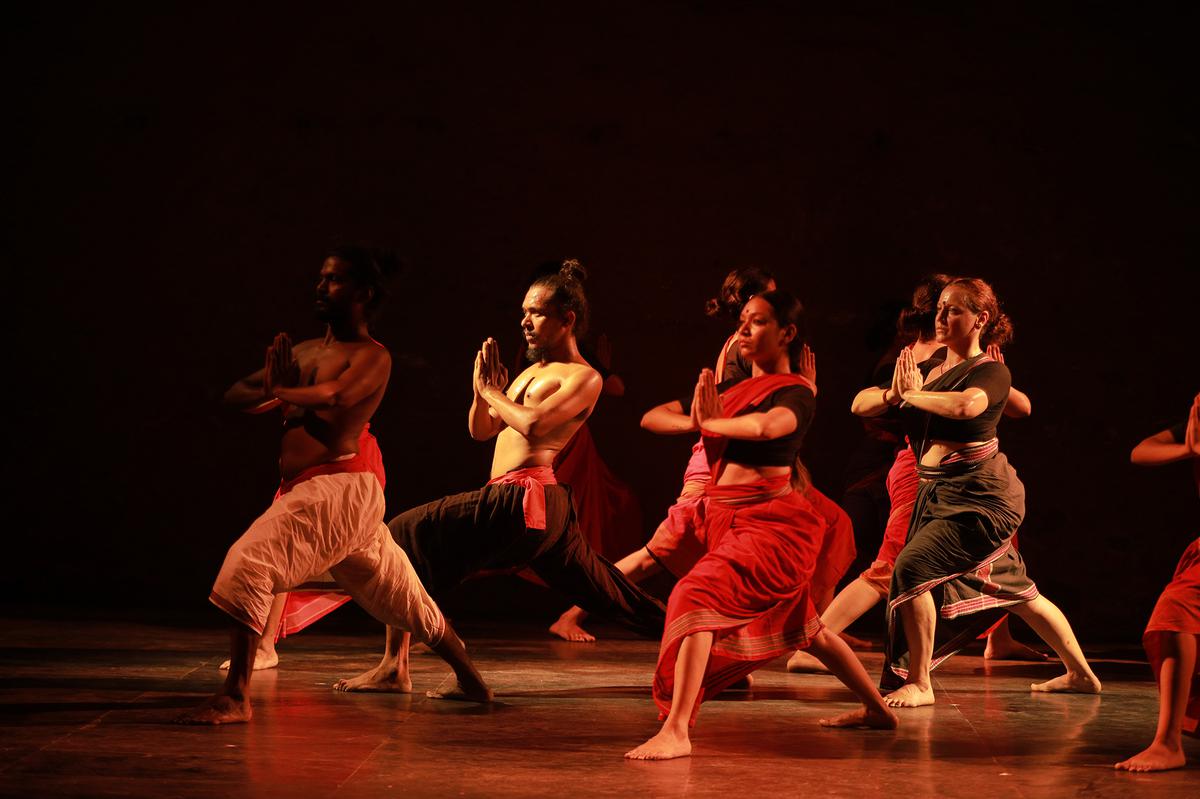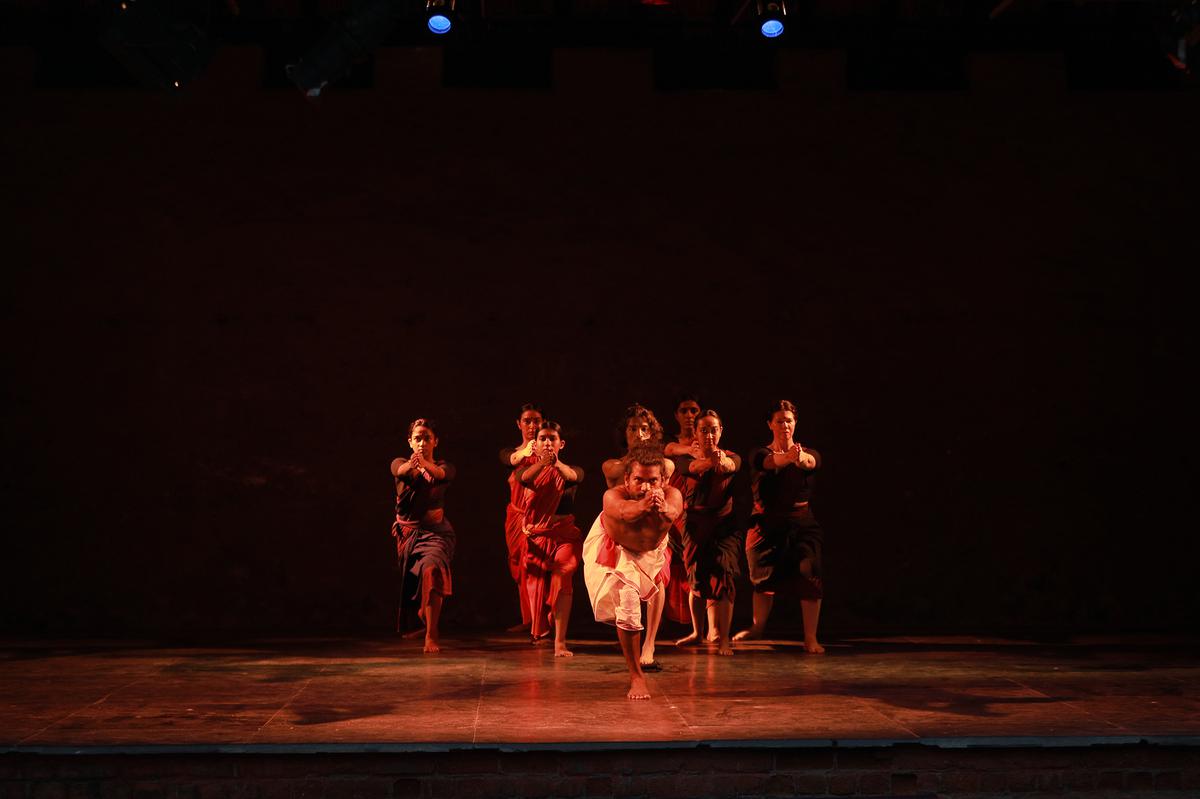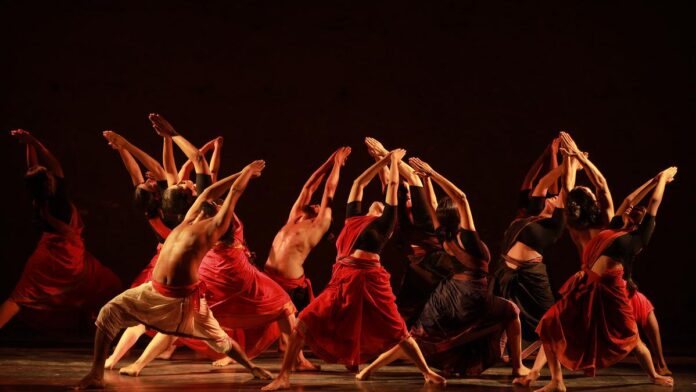
Dancers performing the reconstructed ‘Prana’ at Spaces in Chennai
| Photo Credit: Karthik
Somethings don’t change with time. Fortunately. Like the comforting silence of Spaces, the sprawling tree-lined arena for the performing arts, one of iconic dancer-choreographer Chandralekha’s many creations.
It’s a warm, humid evening. The sun has set and you can still hear the crows caw. The intimate bare proscenium is lit by mellow lights. There is nothing decorative about the presentation — a reconstruction of Chandralekha’s popular work ‘Prana’. The unfussy costume seems to emphasise the crucial element of the choreographer’s aesthetic — to make the moving body clearly visible. The no-make up look keeps the focus on the physical exploration of the piece. The small and involved audience is seated on dhurries, chairs and granite slabs. The recording of B. Krishnamurthy’s singing of Dikshitar’s kritis and Ellappa Pillai’s (Chandralekha’s guru) jathi rendition do not overpower the visual.
The piece that blends dance and yoga has the body and breath as its core. Through outstretched arms and legs, bending of the torso, powerful stamping of the feet, and graceful leaps and jumps, it explores the raw energy of the body and the dynamics of the movements when freed of all forms of narratives.
Watch | Padmini Chettur talking about reconstructing Chandralekha’s popular work ‘Prana’ at Spaces
| Video Credit:
Chitra Swaminathan
The 16 dancers who staged the reconstructed ‘Prana’ rehearsed for four hours every day over two weeks to understand and imbibe the spirit and intent of the original work. It all happened at a workshop conducted by Padmini Chettur, Meera Krishnamurthi and Krishna Devanandan, who have worked with Chandralekha for over a decade. “The effort was not to rekindle nostalgia but to keep alive her works on the stage and in the bodies of young students of dance,” said Padmini during a post-performance interaction with the audience. Participants at the workshop were allowed to question, critically analyse and have unconstrained conversations about Chandralekha’s approach. March Dance, the annual contemporary dance festival organised by Basement 21 in collaboration with Goethe-Institut/Max Mueller Bhavan in Chennai, made this possible.

Public sharing of Chandralekha’s reconstructed ‘Prana’
| Photo Credit:
Karthik
Understanding dance history
With quite a lot of contemporary work happening in the dance world today, Chandralekha’s movement vocabulary may not seem novel, but few choreographers have been able to put their own stamp on the art form like she did. Because not all those desiring to step into a new terrain honour and understand the history of dance. Hence, reconstruction of works that influenced artistes and generated trends is essential. It’s an intriguing process since it involves mounting an old work on a new set of dancers, and the challenge of not compromising with the choreographer’s vision and style.
“The learning at the workshop had to be given a completion with a public sharing. Reconstruction for us began with notating the piece from looking at film records. Meera and I then taught it to the dancers depending on their capacities. Also, the participants came with different dance experiences. So some shifting and adjustments had to be done. Some had no engagement with yoga and kalari. They picked it up here. The openness was enjoyable,” said Padmini.
Reconstruction are generally seen as attempts to resurrect danceworks that have been long-forgotten. On the contrary, it involves a substantial amount of creativity as it has to be set in a fresh context and frame.
“It was not re-performance in the true sense because the dancers were re-imagining the piece, created 30 years ago, in the now. For me, this was close to live-archiving of Chandra’s work, which I think is more significant than videos or intellectual texts,” said Padmini.

March Dance facilitated the reconstruction of Chandralekha’s ‘Prana’ by Padmini Chettur, Meera Krishnamurthy and Krishna Devanandan
| Photo Credit:
Karthik
According to Meera, “You have to physically incorporate what is happening around you. That cannot be taught, it can only be felt.” Kim Jones, a former Martha Graham Company dancer, who, in 2013, reconstructed the legendary choreographer’s lost 1935 solo work, ‘Imperial Gesture’ had pointed out how the work was hugely impacted by the rise of fascism in Europe, workers’ rights, and the emergence of American expressive dance.
Summing up the emotion of becoming aware of one’s body, breath and surrounding, a young dancer after the workshop said she will now go back with a toolbox of resources that she could apply in her practise in the future.
#reconstruct #30yearold #dance #piece #created #iconic #Chandralekha
